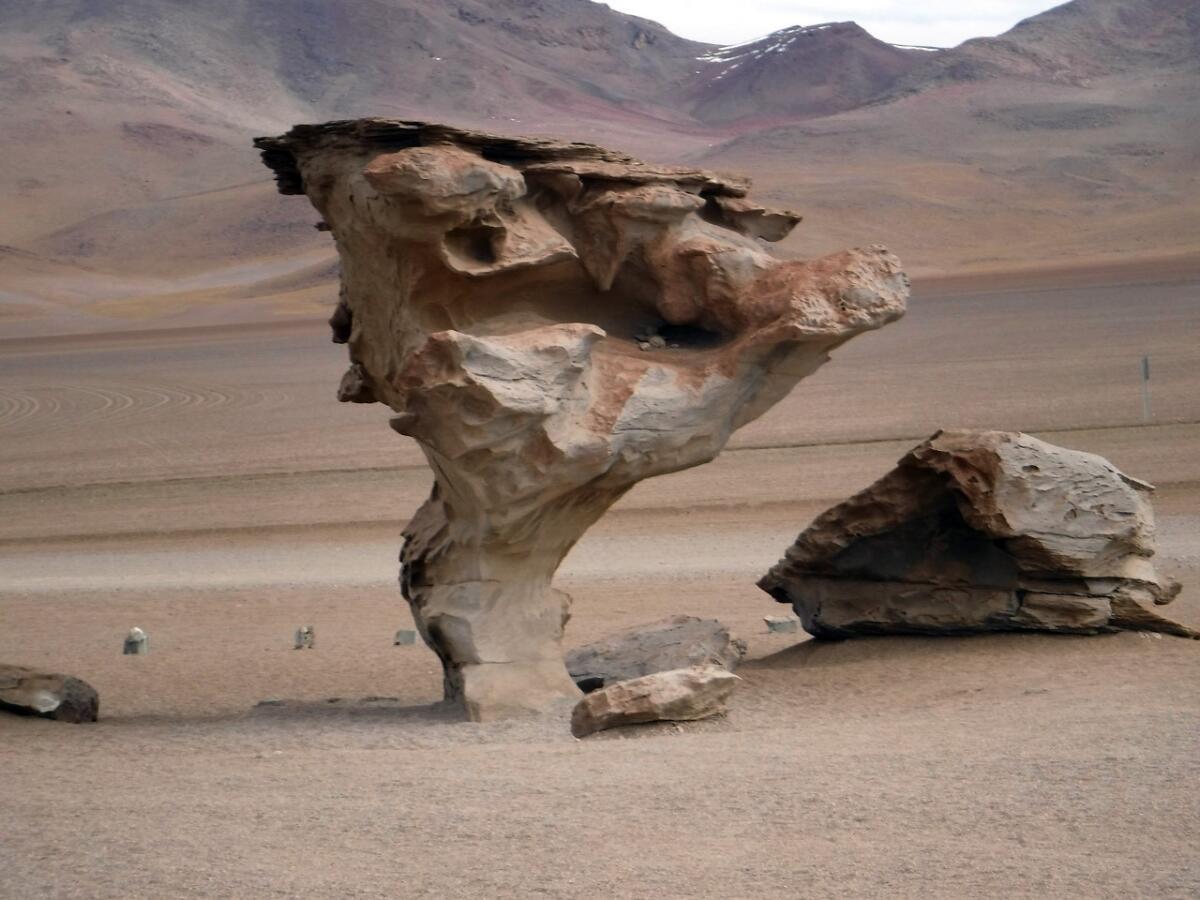Bolivia’s ethereal Salar de Uyuni salt flats will shake your worldview

The salt deposits in Bolivia’s Salar de Uyuni make interesting shapes amid an ethereal landscape.
In the southwestern corner of Bolivia, about an hour’s flight from La Paz, the blinding white Salar de Uyuni salt flat stretches for more than 4,500 square miles. There is no place else like it in the world.
At nearly 12,000 feet above sea level, the Salar dazzles the eye and plays optical tricks on you with what look like white hexagonal tiles of salt that seem to go on forever. In winter (our summer), you can drive across it. In summer (our winter), the Salar becomes a giant puddle, and the reflection of sky and clouds seems to reflect the entire world.
The Salar was formed after a lake dried up that had covered most of southwestern Bolivia between 40,000 and 25,000 years ago. Another lake lasted about 1,000 years. Salt deposits were leached from the surrounding mountains and, with no outlet to the sea, were deposited here, the lowest point on the Altiplano plateau. (An estimated 50% of the world’s lithium, used in batteries and cellphones, is under the Salar.)

Rocks sculpted by wind in the Altiplano. Temperatures drop below freezing during the winter months of July and August.
Until 2011 the Uyuni airport was just a landing strip for mining companies. Now there is a terminal, an extended runway and daily flights from La Paz. Visitors can now get to the salt flats without spending days to do so.
We took a 6 a.m. flight to Uyuni and arrived before sunrise to begin our three-day tour with Red Planet Expeditions (www.redplanetexpedition.com, about $190 per person). We hurtled across the salt flats in our caravan made up of three 4X4s, each with four to six people, and climbed around the “island” of Incahuasi, a rocky land mass (and national park) that rises out of the salt flats and is covered with cactuses.
We sat on top of the world in this vastness and listened to the silence and the wind. My boys, Theo, 12, and Benji, 10, were awed by the sheer magnitude of the landscape. Benji wanted to taste the salt (which you cannot do unless it is processed).
We took ridiculous pictures on the salt flats, playing with the lack of perspective caused by the flatness, the whiteness and the hazy blue distance of the horizon. We saw herds of wild vicuñas and chased domesticated llamas out grazing for the day. We saw fields of quinoa, a protein-laced grain with which America seems to be having a love affair, and rock formations sculpted by the desert winds. We saw an Andean fox, which looks like a hairier version of its American counterpart. Wild ostriches ran alongside our 4X4, their feathers bouncing. We were really lucky to see them.
On the second day of the tour we visited the Reserva Nacional de Fauna Andina Eduardo Avaroa, a national park that is Bolivia’s most visited and protected area. We saw volcanoes, geysers, flamingos and red and green lagoons. Although it was bone-chillingly cold — it was the dead of the Bolivian winter — that night we soaked in a natural hot spring under a sky full of stars.
The trip was exhilarating for the otherworldly landscapes and wildlife. Although we had a great guide and chose a well-regarded tour operator, the excursion was also grueling because of the endless miles bouncing over rutted, sometimes nonexistent, roads and the bitterly cold nights at high altitude. We slept inside simple buildings but there was no heat. We had purchased extra clothes in La Paz and at night wore everything we had and used hot water bottles, but we were still cold.
As Salar de Uyuni develops as a tourist destination, a trip here will get easier but it will never get more beautiful.
MORE:
Mining the history of a Bolivian silver town well worth the trip
Bolivia’s raw beauty calls to travelers looking for adventure
La Paz’s cable-car system Teleferico a heady ride that bridges Bolivia’s values
More to Read
Sign up for The Wild
We’ll help you find the best places to hike, bike and run, as well as the perfect silent spots for meditation and yoga.
You may occasionally receive promotional content from the Los Angeles Times.






